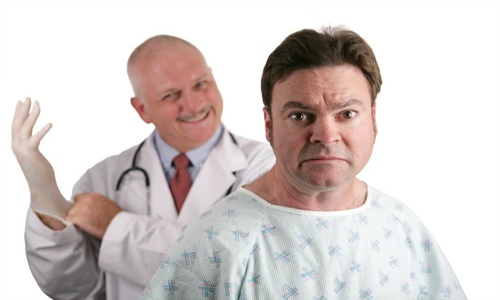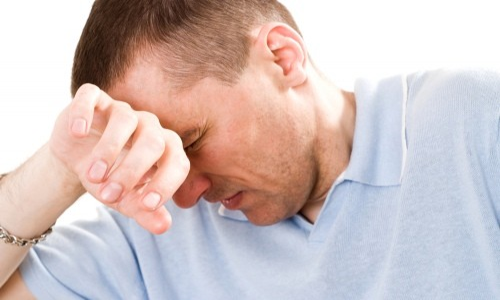What is prostatitis - this issue worries many representatives of the stronger sex. People in the modern world have many temptations that lead to the development of pathology. A man should not ignore any symptoms that indicate the presence of prostatitis. Men try to keep secret various pathologies in the reproductive system, although this is wrong. In modern medicine, prostatitis with timely and correct treatment is quickly docked.
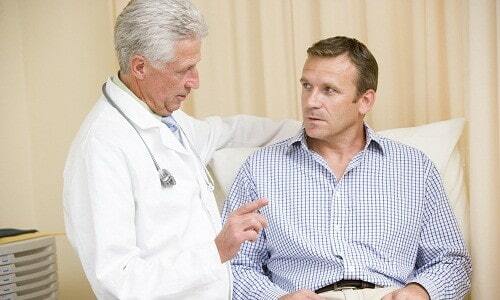
Etiology of the disease
In the male body, there is iron, which is characteristic only of the stronger sex. This gland is called prostate or prostate. Prostate is responsible for the production of male hormones in the body. The gland consists of soft tissues and has ducts. Through the ducts, various infections and pathogens can enter the prostate. Microbes cause inflammation in the soft tissues of the gland. Prostate under the influence of inflammation begins to increase in size and pressure on the internal organs of the small pelvis. The whole process is called prostatitis.
Because of what the disease can develop
Many factors influence the development of prostatitis in the human body. Many reasons remain unnoticed for men. The disease begins to develop actively and cause discomfort, in some cases can cause serious complications. The causes of prostatitis are:
- Infections;
- Noninfectious factors.
 Various pathogens of infections affect the appearance of inflammation in the prostate. The main danger is infection, which is transmitted sexually. STIs are not amenable to drug treatment, and some are incurable. Prostatitis can also be caused by microorganisms trapped in the blood from other pathogenic foci. On the development of the disease can affect chronic diseases of the nasopharynx, gastrointestinal tract and urogenital system. Malicious microbes can get into the prostate during surgery.
Various pathogens of infections affect the appearance of inflammation in the prostate. The main danger is infection, which is transmitted sexually. STIs are not amenable to drug treatment, and some are incurable. Prostatitis can also be caused by microorganisms trapped in the blood from other pathogenic foci. On the development of the disease can affect chronic diseases of the nasopharynx, gastrointestinal tract and urogenital system. Malicious microbes can get into the prostate during surgery.
The rest of the reasons doctors consider non-infectious factors. Prostatitis can occur with a low-activity lifestyle, malnutrition, reduced immunity. In people suffering from diabetes and hypertensive disease, prostatitis is a concomitant disease. Various injuries of internal organs or soft tissues cause the development of pathology in the body of a man. Alcohol abuse and smoking also affect inflammation in the gland. Men suffering from obesity are at risk because prostate mass is suppressed by excess fat mass and displaced internal organs.
Types of the disease
The disease has a different etiology. Due to the formation process prostatitis is divided into two large groups:
- Prostatitis bacterial form;
- Not a bacterial disease.
Bacterial form of the disease can occur unexpectedly, such a pathology is called acute form. Acute prostatitis of bacterial form is the most dangerous type of disease. Pathology appears sharply and is accompanied by a high body temperature. A man who has this type of disease begins to fever, has severe cutting pains in the lower abdomen, the process of urination becomes more difficult. Bacterial prostatitis should be treated in a hospital. If you do not seek help from a specialist in time, a fatal outcome may occur.
The pathology caused by bacteria does not always flow sharply. The most common form of prostatitis is chronic.
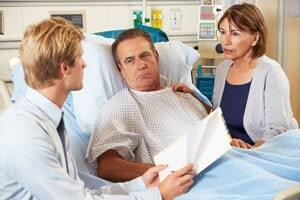 The first symptoms of the disease go unnoticed. The disease is detected with a stationary examination or with the delivery of tests. This form is dangerous because the causes that caused inflammation remain unrecognized. The bacterium can die for a long time in the body, and the inflammation remains and develops further. The chronic form of bacterial prostatitis is treated for a long time.
The first symptoms of the disease go unnoticed. The disease is detected with a stationary examination or with the delivery of tests. This form is dangerous because the causes that caused inflammation remain unrecognized. The bacterium can die for a long time in the body, and the inflammation remains and develops further. The chronic form of bacterial prostatitis is treated for a long time.
Not a bacterial form of pathology is divided into chronic and asymptomatic species. Chronic form is similar to bacterial, but is caused by external factors. The non-bacterial prostatitis is affected by the wrong way of life, trauma to the pelvic organs, prolonged sitting, obesity. Not a bacterial form is treated much faster than all the others, since the inflammation is removed by monotherapy.
Asymptomatic prostatitis is a latent form of the disease that occurs without visible symptoms.
The danger of this pathology is the development of cancerous tumors and abscesses. This type of prostatitis can be detected only with ultrasound diagnosis of pelvic organs. Therefore, it is recommended that men visit the ultrasound examination room at least once every 6 months.
Symptoms of the disease
Prostatitis can occur in men both at a young age, and in a mature. The most common disease occurs in people aged 30-40 years. With age, the percentage of patients increases. Prostatitis can be detected in the early stages with a careful attitude to your body. The appearance of the following signs indicates a pathology:
- Problems with urination;
- Cutting or aching pain in the lower abdomen;
- Pain when urinating or defecating;
- Frequent urge to go to the toilet( especially frequent at night);
- The presence in the urine of any inclusions or impurities of blood;
- Erectile function disorder;
- Pain in intercourse.
 When collecting an anamnesis, the patient complains of problems with urination. Urine can go out slowly or drip. In severe cases, the fluid is released spontaneously. The patient has low back pain, which is worse when you visit the toilet. A man becomes irritable, inattentive, depression may occur. Frequent overnight visits to the toilet cause nervous overexertion and prolonged stress. Sexual life becomes inactive. Some patients lose their libido. A severe form of pathology causes impotence. Acute bacterial disease can lead to the development of sepsis. In this case, immediate medical treatment is required.
When collecting an anamnesis, the patient complains of problems with urination. Urine can go out slowly or drip. In severe cases, the fluid is released spontaneously. The patient has low back pain, which is worse when you visit the toilet. A man becomes irritable, inattentive, depression may occur. Frequent overnight visits to the toilet cause nervous overexertion and prolonged stress. Sexual life becomes inactive. Some patients lose their libido. A severe form of pathology causes impotence. Acute bacterial disease can lead to the development of sepsis. In this case, immediate medical treatment is required.
Prolonged course of the disease can cause problems with conception. Seed fluid loses its density, the structure of spermatozoa changes, in some cases, their death is possible. In laboratory studies, seminal fluid has a weak consistency, becomes lighter and more transparent. Treatment of infertility caused by prostatitis is very long and expensive.
Diagnosis of the disease
To make an accurate diagnosis, a man needs to undergo an examination with a doctor and take tests. With prostatitis, the patient has pain from palpation in the perineal region. Internal palpation of the rectum shows the presence of swelling in the area of the prostate gland, to the touch it becomes dense. The patient complains of problems with the genitourinary system. After collecting an anamnesis, the patient must pass a detailed blood test for the presence of protein excess, elevated white blood cell count and prostatic antigen.
To exclude infection, the patient must pass a smear from the urethra. In the laboratory, they will sow the detected bacteria and test their sensitivity to certain types of antibiotic agents.
For an accurate picture, an ultrasound examination of the pelvic organs is performed. It clearly shows inflammation and enlargement of the prostate. If the gland has grown strongly, then on ultrasound, you can see the presence of residual urine in the bladder.
After all the tests and examinations, the man will be diagnosed and prescribed treatment.
Treatment of prostate inflammation
Prostatitis therapy is complex and includes several groups of drugs. For the treatment of medicines such as:
-
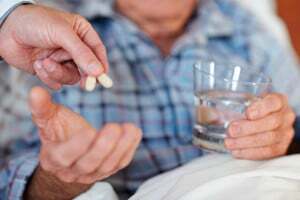 Antibiotic;
Antibiotic; - Non-steroidal anti-inflammatory substances;
- Reductase inhibitors;
- Analgesic drugs.
Antibiotics are the main treatment for prostatitis. For the selection of an effective drug, the sensitivity of the microorganisms that caused the disease is elucidated. Drugs are selected from the groups of macrolides, cephalosporins and fluoroquinolones. Tavanik has a strong positive effect. It contains levofloxacin. The medicine shows a positive dynamics on the 3rd day of treatment. Reception "Tavanika" can last as much as 10 days. The remaining antibiotics are prescribed up to 14 days.
Non-steroidal anti-inflammatory drugs are used to stop the inflammatory process in the prostate gland. Substances are used in various forms. With prostatitis, NSAIDs are usually given in the form of candles. The local effect of the drug quickly removes swelling from the soft tissue of the gland."Vitaprost forte" candles are popular. The course of treatment can be 7 days. The drug has an additional analgesic effect and soothes itching in the area of the anus.
Reductase blockers are used to treat problems with urination. Doctors appoint "Finasteride".The medicinal substance helps to block the process of converting testosterone into dihydrostosterone. Dihydrosterone affects the proliferation of the prostate. After two days of taking the medicine, the pressure on the base of the bladder decreases and the outflow of fluid is restored. Therapy with finasteride is long. The drug is taken throughout the course of therapeutic effects.
Analgesics are prescribed to patients who have severe and severe pain. The drug is selected by a doctor. Do not take analgesics for more than 5 days.
Self-administered treatment is not recommended. What is prostatitis and how to deal with it should tell the doctor.

